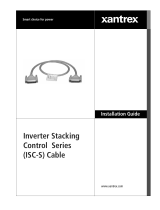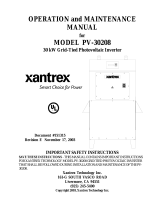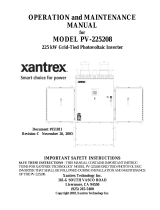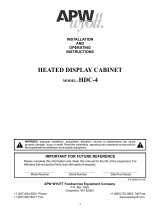
OPERATION and MAINTENANCE
MANUAL
for
MODEL PV-15208
15 KW Grid-Tied
Photovoltaic Inverter
Document #150919
Revision B November 13, 2000
IMPORTANT SAFETY INSTRUCTIONS
SAVE THESE INSTRUCTIONS - THIS MANUAL CONTAINS IMPORTANT INSTRUCTIONS
FOR TRACE TECHNOLOGIES MODEL PV-15208 GRID TIED PHOTOVOLTAIC INVERTER
THAT SHALL BE FOLLOWED DURING INSTALLATION AND MAINTENANCE OF THE PV-
15208.
Xantrex Technologies Inc./Trace Technologies Corp.
161-G SOUTH VASCO ROAD
Livermore, CA 94550
(925) 245-5400
Copyright 2000, Xantrex Technologies Inc./Trace Technologies Corp.

Table of Contents
Section 1: Product Description
Introduction
Major Components
Interconnection Standards Compliance
Specifications
Equipment Symbol
Section 2: Safety
Safety Features
Isolation Procedure
Anti Island Protection
Section 3: Installation And Initial Turn-On
Isolation Transformer Requirements
Torque and Wire Gauge Specifications
Installation Instructions
Interconnection Wiring
Initial Turn On Procedure
Section 4: Operation
Description of System Operation
Operator Interface Panel (LED and LCD)
Example of Normal System Operation
Section 5: Troubleshooting
General
Fault Conditions and Troubleshooting
Fault Clearing
Fault Descriptons and Troubleshooting
Section 6: Preventative Maintenance
Isolation Procedure
Turn-On Procedure
Section 7: Drawings and Major Parts Lists
System Schematic, Grid Tied PV Inverter, PV-Series
Assembly Drawings And Major Parts Lists
Envelope Drawing, Grid Tied PV Inverter, PV-15208
UL Listing Document, April 25, 2000
UL Listing Card, September 8,2000
Accessories

SECTION 1
PRODUCT DESCRIPTION
PV-15208 Photovoltaic Inverter
Operation and Maintenance Manual
Copyright 2000, Xantrex Technologies Inc./Trace Technologies Corp.
DOCUMENT: 150919
1-1
INTRODUCTION
The Trace Technologies Model PV-15208 is a 15KW Grid Tied Photovoltaic Inverter. It utilizes ad-
vanced power electronics to allow interface of a photovoltaic array with a utility grid. The PV-15208 is
a highly integrated assembly, consisting of an inverter bridge and associated control electronics all on a
single board. The PV-15208 control software provides for complete overall system control with a vari-
ety of protective and safety features.
MAJOR COMPONENTS
The major components of the PV-15208 are identified in Drawing No. 150921.
Main Enclosure
The enclosure (shown in Figure 1-1) is NEMA-4 rated. The PV-15208 enclosure contains the Inte-
grated Bus Board, output line filter (insuring that the PV-15208 line currents and voltages meet IEEE-
519 harmonic distortion requirements), control power transformers, and A/C contactor (PV-15208 A/
C output to the grid). Also found within the enclosure are the system protection devices (control power
circuit fuses). The front door of the enclosure contains the operator interface panel (three LED’s or
LCD and an on/off switch).
Figure 1-1
Figure 1-2

SECTION 1
PRODUCT DESCRIPTION
PV-15208 Photovoltaic Inverter
Operation and Maintenance Manual
Copyright 2000, Xantrex Technologies Inc./Trace Technologies Corp.
DOCUMENT: 150919
1-2
Integrated Bus Board
The PV-15208 design makes use of a fully integrated bus board as shown in Figure 1-2. The bus board
assembly is mounted to an aluminum extrusion heat sink, which mounts through an opening in the back
of the enclosure. The power electronics is comprised of a six pack of IGBT devices, mounted to the
heat sink. The bus board is mounted on top of the IGBT six pack device, and is supported through a
series of standoffs attached to the heat sink.
The bus board contains all of the necessary control functions to drive the (attached) switching transis-
tors. The bus board contains the following functional circuits: D/C control power supplies (+5V, +/-15V
and four isolated +15V sources for the IGBT’s), A/C and D/C high voltage measurement, A/C and
ground current measurements, contactor and indicator controls, discrete input sensing (on/off switch),
and closed loop PWM modulators. The bus board contains a micro-controller chip to perform the low-
level control functions associated with the collection of measurement and driving the pulse width modu-
lators.
A plug in DSP module controls the bus board. The DSP module is designed to the industry standard,
PC-104 specification, and is used to perform the majority of the calculations needed to control the bus
board. The most significant tasks are: control of PV-15208 electromechanical components and power
electronics converters, signal conditioning (digital filtering and transformations), and communication
with the operator interface panel and system sensors.
The PV array ties directly to the DC bus. The inverter controller manages the transfer of power between
the DC bus and the utility grid.
INTERCONNECTION STANDARDS COMPLIANCE
The PV-15208 has been tested and certified by Underwriters Laboratories to be in compliance with
UL1741 Static Inverters And Charge Controllers For Use In Photovoltaic Power Systems, as well
as IEEE-P929 Recommended Practice For Utility Interface Of Photovoltaic (PV) Systems.
IEEE-P929 provides guidance regarding equipment and functions necessary to ensure compatible op-
eration of photovoltaic systems which are connected in parallel with the electric utility. UL1741 is the
test procedure performed by Underwriters Laboratory on the PV-15208 to verify it meets the recom-
mendations of IEEE-P929. Refer to both documents for details of these recommendations and test
procedures.
CAUTION
The fuses within the PV-15208 are intended for protecting the PV-15208 control cir-
cuitry only. They are not intended to provide protection for the PV array or external
cabling.

SECTION 1
PRODUCT DESCRIPTION
PV-15208 Photovoltaic Inverter
Operation and Maintenance Manual
Copyright 2000, Xantrex Technologies Inc./Trace Technologies Corp.
DOCUMENT: 150919
1-3
egatloVeniLCAlanimoN%01±,CAV802
tnerruCeniLCAmumixaM )egatlovenilwolta(SMRA62.64
ycneuqerFeniLlanimoNzH5.0±,zH06
daoLCAsuounitnoCCAv802@WK0.51
egnaRegatloVVPCDV006-033
tnerruCmumixaMVPCDA8.74
noitarugifnoCVP
ralop-ibro,dednuorgevitagenraloponoM
dnuorglartuen
erutarepmeTgnitarepO*C°05ot02-
erutarepmeTegarotSC°05ot04-
gnitaRerutarepmeTtneibmAmumixaMC°05
ytidimuHevitaleRgnisnednoc-noN,%59oT
noitavelEteef006,6evobadetareD
)sehcnini(snoisnemiD41X52X03
thgieW.sbl571.xorppA
epyTerusolcnE4AMEN
eliFgnitsiLLU653991E-eliF
EQUIPMENT SYMBOL
Chassis ground – Customer supplied system ground connection point. This symbol may be found near a
stud within the main enclosure. It is provided as a location to bond the electrical system equipment
ground.
*If ambient temperature is between -20 to 0° C, the unit must be powered up in standby for at least
one hour prior to going on-line.
SPECIFICATIONS
The PV-15208 has been designed for photovoltaic power systems, which operate within the following
specifications. Application of the PV-15208 in a manner inconsistent with these specifications may
cause damage to the PV-15208 and other system components, and is a violation of the terms of the
warranty.

DOCUMENT: 150919
SECTION 2
SAFETY
PV-15208 Photovoltaic Inverter
Operation and Maintenance Manual
Copyright 2000, Xantrex Technologies Inc./Trace Technologies Corp.
2-1
SAFETY FEATURES
Front Panel Indicators
The PV-15208 incorporates three colored LED indicators, used to show the current operating state of
the inverter. The indicators have the following meanings:
• Red: Fault Mode - The inverter has sensed an abnormal condition. To reset the unit (clearing the
fault condition), cycle the on/off switch (see below).
• Amber: Sleep Mode – The inverter is waiting for sufficient PV voltage to start the inverter.
• Green: Operator Mode - The inverter is active and generating A/C current.
On/Off Switch
The PV-15208 incorporates a maintained position on/off switch located on the front door of the enclo-
sure. Under normal conditions, the on/off switch in the on position. Turning the switch to the off
position will initiate a controlled shutdown of the PV-15208 and open the main contactor within the
unit. The PV-15208 is prevented from being restarted until the on/off switch is turned back to the on
position. Cycling the on/off switch will reset the PV-15208 and attempt to clear any system fault.
Main Enclosure Door
The front door of the PV-15208 main enclosure is pad lockable. It is recommended that the PV-15208
enclosure door be padlocked during normal operation.
Fault Reporting
Any fault conditions are reported to the operator interface. If the PV-15208 is equipped with LED’s,
the red LED will light and the green LED will flash the corresponding number of the fault. If the PV-
15208 is equipped with the LCD option, the LCD will display a text description of the fault. Refer to
Section 5, Troubleshooting, for detailed descriptions of system fault conditions.
PV Ground Fault Detection
The PV-15208 is equipped with ground fault detection circuitry and control. The single point of PV
The PV-15208 enclosure contains exposed high voltage conductors. The enclosure
door should remain closed, except during maintenance or testing. These servicing
instructions are for use by qualified personnel only. To reduce the risk of electric
shock, do not perform any servicing other than that specified in the operating
instructions unless you are qualified to do so. Do not open the cabinet door if
extreme moisture is present (rain or heavy dew).
WARNING
The PV-15208 does not incorporate a door interlock switch. Please make sure the
unit is powered down, and isolated from the utility grid and PV panels, prior to
opening the enclosure door. (Allow 5 minutes for any stored potentials to be dis-
charged, prior to opening the unit). The front door of the PV-15208 main enclosure
is pad lockable. It is recommended that the PV-15208 enclosure door be padlocked
during normal operation.
WARNING

DOCUMENT: 150919
SECTION 2
SAFETY
PV-15208 Photovoltaic Inverter
Operation and Maintenance Manual
Copyright 2000, Xantrex Technologies Inc./Trace Technologies Corp.
2-2
The terminals of the PV input may be energized if the arrays are energized. In
addition, allow 5 minutes for all capacitors within the enclosure to discharge after
disconnecting the PV-15208 from AC and DC sources.
WARNING
ISOLATION PROCEDURE
The following procedure should be followed to de-energize the PV-15208 for maintenance:
ANTI ISLAND PROTECTION
A digital phase-shift-loop (PSL) circuit is implemented in the DSP inverter controller to prevent
“Islanding” of the PV-15208.
The DSP continuously makes minor adjustments to the power factor phase angle above and below
unity. In the event of a utility outage, these adjustments destabilize the feedback between the inverter
and the remaining load, resulting in an over/under frequency or voltage condition. The PV-15208
then performs an orderly shutdown. The fault condition will remain until the utility voltage and
frequency have returned to normal for 5 minutes.
This method has been extensively tested and proven to exceed the requirements of UL 1741.
system ground must be routed through CT1 on the main control board (see section 3, installa-
tion and section 7, system schematic for further detail). Upon detection of 1.5 amps of ground
fault current, the PV-15208 executes an orderly shutdown, and annunciates a ground fault at the
operator interface. The PV-15208 will remain faulted until the ground fault is remedied and
cleared at the operator interface (see section 5, troubleshooting).
1. Turn the on/off switch to the off position.
2. Open the PV array disconnect switch (if present).
3. Open the AC interface disconnect (if present).
4. Open the isolation transformer circuit breaker.
5. Install lockout devices on the isolation transformer circuit breaker and PV disconnect switch (if
present).

SECTION 3
INSTALLATION AND INITIAL TURN-ON
PV-15208 Photovoltaic Inverter
Operation and Maintenance Manual
Copyright 2000, Xantrex Technologies Inc./Trace Technologies Corp.
DOCUMENT: 150919
3-1
ISOLATION TRANSFORMER REQUIREMENTS
The PV-15208 is required to have an isolation transformer wired between the inverter AC output and
the utility interconnection. Any standard dry-type isolation transformer is compatible with the PV-15208
as long as the inverter side is rated for a minimum of 15KVA continuous duty.
Inverter Side Isolation Transformer Requirements
The inverter side transformer windings may be configured either delta or WYE, and must be rated for
208 VAC. Trace Technologies recommends using a delta wound transformer to avoid installation mis-
takes. If a WYE wound transformer is used to interface with the PV-15208, and the PV array is
grounded, the neutral (X0) must be left floating. If the neutral is tied to ground, the inverter will not
function properly, and may be damaged.
Utility Side Isolation Transformer Requirements
The utility side isolation transformer windings may be configured either delta or WYE, and must be
rated for the utility voltage at the point of utility inter-connection. Check with the utility of jurisdiction
when selecting an isolation transformer configuration. If a WYE wound transformer is used to interface
with the utility, it is not necessary to connect the neutral (X0) to ground. The PV-15208 is a balanced,
three phase, current sourcing inverter, and only operates with the presence of a stable utility voltage.
Single phase grounded loads which may be present between the transformer and utility, will maintain
their existing ground reference at the utility distribution transformer. Grounding the neutral of a WYE
wound transformer may create an “open delta” condition, depending on the utility configuration. This
condition may keep the PV-15208 from detecting a loss of phase condition on the utility system,
which may allow potentially lethal voltage to be present on the open phase wiring.
Contact your Xantrex/Trace Technologies distributor if you have any questions regarding isolation trans-
former requirements.
Check with the local utility of jurisdiction when selecting the winding configura-
tion of the isolation transformer. Individual utilities may have unique require-
ments related to isolation transformer wiring. Some winding configurations may
keep the PV-15208 from detecting a loss of phase condition on the utility system
which may allow potentially lethal voltage to be present on the open phase wir-
ings.
WARNING
TORQUE AND WIRE GAUGE SPECIFICATIONS
The following torque specifications are to be used on all electrical interfaces made during installation of
the PV-15208.
eziStloBrokcolBlanimreTgnitteSeuqroT
1-6MmN9.5/.sblni25
23126tumwahS/zarreFmN6.31-3.2/sblni021-02
Torque Table

SECTION 3
INSTALLATION AND INITIAL TURN-ON
PV-15208 Photovoltaic Inverter
Operation and Maintenance Manual
Copyright 2000, Xantrex Technologies Inc./Trace Technologies Corp.
DOCUMENT: 150919
3-2
All wiring methods shall be in accordance with the National Electrical Code ANSI/
NFPA 70. All power conductors interfacing to the PV-15208 should be sized in
accordance with the National Electric Code ANSI/NFPA 70 and local codes. Large
gauge wire must have a minimum bend radius dependent upon the wire gauge
(refer to the National Electric Code, Article 373-6B). Take care to keep the wire
bundles away from any sharp edges which may damage wire insulation over time.
Trace Technologies recommends using No. 6 AWG, 105 degrees C, minimum,
copper wire for all connections with the PV-15208.
CAUTION
Ventilation Considerations
1. Maintain a minimum 6” clearance above and below the PV-15208 for proper cooling fan operation.
2. Maintain a minimum 1” clearance to the left and right of the PV-15208.
Installation
1. The unit must be mounted at least 3’ off the ground, and 12” above any horizontal surface.
2. Screw two 3/8” x 3-1/2” long lag bolts into existing studs in the wall (16-inch mounting center) at
lower mounting level on PV-15208. Lag bolts should be horizontally level with each other. Leave
a minimum of 1” of bolt protruding from the wall.
3. Place the PV-15208 bottom mounting ears, shown in Figure 3-1 and Figure 3-2 onto installed lag
bolts. (See following page.)
4. Hold the unit against wall and install upper lag bolts (3/8” x 3-1/2”). Tighten bolts firmly.
5. Tighten lower lag bolts while unit is held in place.
6. Install two 1-1/2” liquid tight connectors (included with the PV-15208) where shown in
Figure 3-3. (See following page.)
INSTALLATION INSTRUCTIONS
noitanimreTGWAegnaReriW
)CA(rotcatnoC01#-3#
)CD(kcolBnoitubirtsiD41#-0/2
The following table shows acceptable wire gauges to be connected to the PV-15208 AC and DC
inputs.
Wire Gauge Table
Figure 3-1

SECTION 3
INSTALLATION AND INITIAL TURN-ON
PV-15208 Photovoltaic Inverter
Operation and Maintenance Manual
Copyright 2000, Xantrex Technologies Inc./Trace Technologies Corp.
DOCUMENT: 150919
3-3
Figure 3-2
Figure 3-3
LIQUID TIGHT CONNECTORS
Array Grounding and Ground Fault Detection
If grounding the PV array is required for monopolar or
bipolar arrays, jumper TB1-2 to a (PV-) cabinet ground
stud. If ground fault detection is required, route this
jumper through CT1 located on the lower right hand
corner of the control board (see the system schematic
for further detail). This must be the only point of PV
grounding for the PV-15208 and the ground fault
detection system to function properly.
CONTROL BOARD & CT1
CT1
The input and output circuits are isolated from
the enclosure, and that system grounding, if re-
quired by sections 690-41 and 690-42 of the Na-
tional Electric Code, ANSI/NFPA 70, is the
responsibiliy of the installer.
CAUTION

SECTION 3
INSTALLATION AND INITIAL TURN-ON
PV-15208 Photovoltaic Inverter
Operation and Maintenance Manual
Copyright 2000, Xantrex Technologies Inc./Trace Technologies Corp.
DOCUMENT: 150919
3-4
To reduce the risk of fire, connect only to a cir-
cuit provided with 65 amperes maximum branch
circuit overcurrent protection in accordance with
the National Electrical Code, ANSI/NFPA 70.
CAUTION
INTERCONNECTION WIRING
The following wires for connecting the PV-15208 to ex-
ternal devices are not provided by Xantrex/Trace Tech-
nologies: (See wiring diagram on the following page.)
Phase-Sequencing
The PV-15208 is equipped with an automatic phase-
detection control algorithm. This allows the utility
interface conductors to be connected in any sequence
convenient at the time of installation. Upon system
initialization at power-up, the PV-15208 determines
the phase sequence of the utility connection and
configures the modulator drivers accordingly.
• 3-Phase 208 VAC inverter output (main contactor, see picture) to terminals of the 208 VAC delta
side of isolation transformer. If the inverter side of the isolation transformer is configured
WYE and the PV array is grounded, the neutral must be left floating. Ground loops will
exist when the inverter starts switching, which will cause the inverter to shut down due to
phase over-currents and may result in damage to the PV-15208. Also, insure that this
neutral is not bonded to the isolation transformer frame.
• System ground to the isolation transformer chassis ground.
• Isolation transformer grid side terminals to line circuit breaker (or the AC disconnect switch if
present).
• PV frame ground to PV-15208 enclosure chassis ground stud.
• PV-15208 enclosure chassis ground stud to the electrical distribution system ground.
• PV+ to the inverter enclosure terminal block TB1-1.
• PV- to the inverter enclosure terminal block TB1-2.
Install all wires listed above. Refer to the system schematics in Section 7 for more detailed terminal
locations.
MAIN CONTACTOR

SECTION 3
INSTALLATION AND INITIAL TURN-ON
PV-15208 Photovoltaic Inverter
Operation and Maintenance Manual
Copyright 2000, Xantrex Technologies Inc./Trace Technologies Corp.
DOCUMENT: 150919
3-5
Wiring Diagram
Frame
Ground
Line Circuit
Breaker
Isolation
Transformer
PV-15208
Inverter
To Single Point Electrical
Distribution System Ground
PV Array
Trace Combiner Box
(Optional)
A
B
C
X1 H1 X2 H2 X3 H3
X0
PV+
PV-

SECTION 3
INSTALLATION AND INITIAL TURN-ON
PV-15208 Photovoltaic Inverter
Operation and Maintenance Manual
Copyright 2000, Xantrex Technologies Inc./Trace Technologies Corp.
DOCUMENT: 150919
3-6
• Verify the PV+, PV-, PV neutral (if array is bipolar), and PV
safety ground are isolated from each other. The PV safety
ground should be bonded to the enclosure ground stud. Re-
fer to system schematic in Section 7.
• Verify all PV fuses are installed (if present).
• Verify PV string diodes are wired properly (if present).
• Verify proper PV voltage polarity at the PV string disconnect/
combiner boxes.
Initial Power
• Close the isolation transformer circuit breaker.
• Verify 208 VAC voltage across the AC disconnect.
• Close the AC disconnect (if present).
• With the DC disconnect switch opened (if present), close one
of the PV array string disconnect devices.
• Carefully measure VDC at the PV disconnect switch. The
value should be the same as at the PV array string disconnect
device. It should also be positive.
• Close the PV disconnect switch (if present).
• Carefully measure VDC across TB1-1 and TB1-2 (PV +/-)
terminal block. The value should be the same as at the PV
INITIAL TURN ON PROCEDURE
The following procedures are intended to verify correct installation and proper operation of the PV-
15208. These steps are to be followed sequentially. Do not continue if any of the steps or results are
unclear. Refer to Section 4 for a detailed description of system operation. Refer to Section 5 for fault
condition descriptions and troubleshooting. Refer to Section 7 for detailed system schematics.
Visual Inspection, Isolation Transformer
• Verify the isolation transformer circuit breaker is open.
• Remove the isolation transformer access panel.
• If the inverter side of the isolation transformer is configured WYE, the neutral must be left floating.
The transformer neutral must not be connected to the utility side neutral, the transformer chassis, or
ground.
• Verify the inverter 208 VAC conductors are connected to the isolation transformer.
• Verify the utility conductors are properly connected to the isolation transformer.
Visual Inspection, PV-15208
• Insure AC and DC disconnect are opened (if present).
• Insure PV array string disconnect switches are opened (if present).
• Open the door of the enclosure, and inspect.
• Verify all wire connections are tight.
• Inspect the cables between the terminal blocks and the matrix driver board. All wire harnesses
should be snap-locked into their respective PCB headers.
Visual Inspection, PV Array Wiring
DC TERMINAL

SECTION 3
INSTALLATION AND INITIAL TURN-ON
PV-15208 Photovoltaic Inverter
Operation and Maintenance Manual
Copyright 2000, Xantrex Technologies Inc./Trace Technologies Corp.
DOCUMENT: 150919
3-7
array string disconnect device. It should also be positive.
• Carefully measure VDC across the matrix + and – busses. The value should be the same as at the PV
array string disconnect switch. It should also be positive.
• Open the PV disconnect switch. The matrix capacitor bank voltage should slowly degrade to near
zero over a 5-minute period.
• Open all PV string disconnect switches.
System Verification
• Ensure the on/off switch is enabled.
• Upon applying 208 VAC power to the PV-15208, observe the three LED indicator lights on the
front door. The LED’s should be switching on and off in a sequenced pattern. The LED’s may be
difficult to see depending on external light conditions. After approximately 15 seconds, the panel
should finish initialization
• Remedy any faults reported. If the fault indicator does not change, the fault condition is still present
(see Section 5). Cycling the on/off switch will reset the PV-15208 and attempt to clear any system
faults. Once all faults are cleared, the amber indicator light will come on indicating the PV-15208 is
in standby.
• Close all PV array string disconnect switches (if present).
• Close the main PV disconnect switch (if present).
• If the PV voltage is above the PV Start Voltage setpoint, and the PV Start Time is exceeded, the PV-
15208 should transition to “Power Tracking” (see Section 4, Operation).
• Depending upon solar conditions, the PV-15208 may not operate at full power. If the PV array is not
experiencing full sun, the PV maximum power tracker will regulate the PV voltage to maintain
maximum PV power output. (See section 4 for further description of the peak power tracker).
• The PV-15208 is now fully operational.
Fine Tuning
• All PV-15208 operating parameters have been set at the factory, based upon prior experience with
various PV arrays. Parameters may be modified using an optional graphical user interface. Contact
your Xantrex/Trace Technologies distributor for further information.
• It is recommended that the PV-15208 be watched during Wake-Up and Sleep Test. If the PV-15208
cycles between operating and sleeping at either of these times, the operating setpoints may not be set
properly. (Refer to Section 4 for a detailed description of PV-15208 operating states). The PV-
15208 should not cycle if the setpoints are set properly.

PV-15208 Photovoltaic Inverter
Operation and Maintenance Manual
Copyright 2000, Xantrex Technologies/Trace Technologies Corp.
DOCUMENT: 150919
4-1
SECTION 4
OPERATION
DESCRIPTION OF SYSTEM OPERATION
Overview
The PV-15208 is a fully automated grid-tied photovoltaic inverter. Manual interaction or control of the
inverter is necessary only in the event of a system fault. The following conditions govern PV-15208
operation:
• Stable utility voltage and frequency must be present for all states of operation.
• Fault states are automatic from any state of operation. A fault will cause the PV-15208 to immedi-
ately stop processing all power. The fault condition will be reported to the operator interface.
• The on/off switch, located on the front door of the PV-15208, must be switched to the on position
for all operating states.
• Cycling the on/off switch attempts to clear any system faults and return the PV-15208 to normal
operation.
Operating States
Control software governs the operation of the PV-15208. There are five main operating states. The
following descriptions depict the LED interface. Inverters configured with LCD displays will indicate
operating states on the display.
• Standby: The amber LED is illuminated. The PCU monitors the status of the PV array and utility
grid, waiting until the PV array voltage is sufficient to export power to the utility.
• Wake-Up: The amber LED is illuminated. Once the PV voltage is sufficient to export power to the
utility grid, the PV-15208 will wait 5 minutes before starting to insure the voltage is not transient in
nature. This keeps the system from cycling during unstable irradiance conditions.
• Power Tracking: The green LED will illuminate while the PV-15208 delivers power to the utility.
This is the standard operating state of the PV-15208. The PV-15208 maximum power tracker will
optimize power output from the PV array. If available PV power is above the maximum power
rating of the PV-15208, the inverter will current limit, which will cause the PV voltage to rise
above the array peak power voltage. The minimum operating voltage of the PV-15208 is 330 VDC.
The power tracker will not track voltage below this point, regardless of the actual peak power
voltage of the PV array.
• Sleep Test: The control system will begin a 5 minute sleep test. This normally indicates the PV
irradiance is declining as the sun sets. If the output power remains below 200 watts during the 5
minute sleep test, the system will transition to standby. The time delay allows the inverter to ride
through any temporary irradiance reductions.
• Fault: The PV-15208 has encountered a fault condition. When this happens, regardless of the PV-
15208 state-of-operation, the PV-15208 will stop processing all power and execute an orderly sys-
tem shutdown. The red LED will illuminate while the yellow and green LED’s flash the fault code
(See section 5, Troubleshooting).
On early versions of the PV-15208, a push-pull Emergency Stop switch was used
instead of the on/off switch. It functioned in the same manner described for the on/
off switch.
NOTE
OPERATOR INTERFACE (LED and LCD)

PV-15208 Photovoltaic Inverter
Operation and Maintenance Manual
Copyright 2000, Xantrex Technologies/Trace Technologies Corp.
DOCUMENT: 150919
4-2
SECTION 4
OPERATION
The standard operator interface on the PV-15208 consists of 3 system status indicator LED’s and an
on/off switch. The LED’s indicate the following states of operation:
• Red LED: Indicates the system is faulted or the on/off switch is switched to the off position. The
inverter will not function while this LED is illuminated. Cycling the on/off switch will attempt to
clear the fault condition and allow the inverter to resume normal operation.
• Amber LED: Indicates the inverter is in standby, waiting for sufficient DC voltage to begin peak
power tracking. This LED will turn off once the PV-15208 begins producing power. In the event of
a fault condition, the amber LED will flash, indicating the beginning of the fault code sequence
(See section 5, Troubleshooting).
• Green LED: Indicates the inverter is on-line and outputting power. In the event of a fault, the green
LED will flash a sequence indicating the fault code (See section 5, Troubleshooting).
The on/off switch is used to enable or disable system operation. The on/off switch is also used to reset
the inverter and clear any system faults.
The PV-15208 may be equipped with an optional Liquid Crystal Display instead of the LED indicators.
The display consists of 4 text lines containing the following information:
• Line 1: System Goal State - This is the target state of the inverter.
• Line 2: System Status - The current operating state of the inverter.
• Line 3: Inverter Output Power or Fault Description - During normal operation, this line will
report the inverter real time output power. If the PV-15208 is faulted, this line will report a descrip-
tion of the fault condition.
• Line 4: PV Voltage - The DC voltage measured at the PV-15208 DC input terminals.
The following is a typical display of the LCD during the five operating states and an on/off switch.
Wake Up
Standby
Power Tracking
Sleep Test
Fault
Emergency Stop
Status: Power Track
Shutdown
Status: Power Track
Power Tracking
Line kVA:
PV Volts:
Status: Power Track
Wake Up Test
Status: Power Track
Sleep Test
Status: Power Track
Faulted
Fault Description
Status: Power Track
Emergency Stop

PV-15208 Photovoltaic Inverter
Operation and Maintenance Manual
Copyright 2000, Xantrex Technologies/Trace Technologies Corp.
DOCUMENT: 150919
4-3
SECTION 4
OPERATION
EXAMPLE OF NORMAL SYSTEM OPERATION
Upon initial application of AC voltage, the LED’s located on the front door will sequentially flash for
approximately 15 seconds. Once the system has finished initializing, the PV-15208 will remain in
standby until adequate PV voltage is available (amber LED is lit). 5 minutes after the PV start voltage
has been reached, the PV-15208 will synchronize to the utility grid and begin peak power tracking the
PV array. The time delay protects the inverter from excessive on/off cycling.
The PV-15208 will continue to process power until the AC output power approaches the operating
losses of the inverter for a period of 5 minutes. The time delay protects the inverter from excessive on/
off cycling.
SYSTEM OPERATING PARAMETERS
The PV-15208 contains a number of system operating parameters which may be field adjusted using an
optional graphical user interface program available first quarter, 2001 (contact Xantrex/Trace Tech-
nologies for further information). All operating parameters have been set at the factory during system
test based upon prior experience with various PV arrays, or to be in compliance with UL1741. In
general, the factory default settings allow for stable and efficient operation of the PV-15208 connected
with any PV array configured for a 330-500 VDC peak power voltage point.
Below is a list of the PV-15208 operating parameters, showing valid ranges and the factory default
settings. Some field adjustable parameters are password protected and may only be changed by trained
service technicians. In particular are parameters relating to utility protection setpoints. These have been
set in the factory to the limits mandated by UL1741. Any changes to these setpoints should be agreed
upon by the local utility and the equipment owner. The ability to adjust the voltage and frequency
setpoints across the actual utility voltage and frequency has been provided as a simulation tool to verify
the PV-15208 accurately detects and responds to a utility excursion. This test should only be performed
by a trained service technician. It is possible to adjust the setpoints in a manner that will prevent the
PV-15208 from functioning.
retemaraPnoitpircseD
resU
elbatteS
egnaR
noituloseR
yrotcaF
tluafeD
gnitteS
drowssaP
detcetorP
tratS_V_VPegatloVpUekaWVP006-233V1.0083
sttaW_potS_VP
tuptuOnwoDtuhSVP
rewoP
0001-001W1.0002
reP_I_xaM_TPP
tuptuOdednammoC
fOtnecrePAsArewoP
rewoPdetaR
001-0A1001*
feR_V_TPP
roFegatloVVPgnitratS
rekcarTrewoPkaeP
006-233V1.0053
-continued-

PV-15208 Photovoltaic Inverter
Operation and Maintenance Manual
Copyright 2000, Xantrex Technologies/Trace Technologies Corp.
DOCUMENT: 150919
4-4
SECTION 4
OPERATION
retemaraPnoitpircseD
resU
elbatteS
egnaR
noituloseR
yrotcaF
tluafeD
gnitteS
drowssaP
detcetorP
petS_V_TPP
rekcarTrewoPkaeP
petSnoitabretreP
egatloV
0.01-0.0V1.05.1
xaM_I_dnuorG
elbawollAmumixaM
tnerruCtluaFdnuorG
0.01-0.1A1.00.3
rebmuNlaireSrebmuNlaireSretrevnI9999-0000A/NteSyrotcaF*
xaM_qerF
elbawollAmumixaM
ycneuqerFytilitU
0.36-0.75zH1.05.06*
niM_qerF
elbawollAmuminiM
ycneuqerFytilitU
0.36-0.75zH1.05.95*
yaleD_xaM_qerF
elbawollAmumixaM
AoTesnopseRemiT
ycneuqerFhgiHytilitU
noisrucxE
06-0elcyC13*
yaleD_niM_qerF
elbawollAmumixaM
AoTesnopseRemiT
ycneuqerFwoLytilitU
noisrucxE
06-0elcyC13*
xaM_CAV
elbawollAmumixaM
egatloVytilitU
6.942-4.661V1.05.022*
niM_CAV
elbawollAmuminiM
egatloVytilitU
6.942-4.661V1.05.591*
yaleD_xaM_CAV
elbawollAmumixaM
AoTesnopseRemiT
egatloVhgiHytilitU
noisrucxE
06-0elcyC15*
yaleD_niM_CAV
elbawollAmumixaM
AoTesnopseRemiT
egatloVwoLytilitU
noisrucxE
06-0elcyC15*

SECTION 5
TROUBLESHOOTING
DOCUMENT: 150919
PV-15208 Photovoltaic Inverter
Operation and Maintenance Manual
Copyright 2000, Xantrex Technologies Inc./Trace Technologies Corp.
5-1
GENERAL
In the event of a fault, the PV-15208 will annunciate the condition at the operator interface. The PV-
15208 will execute an orderly shutdown and remain faulted until the fault is cleared (manually or auto-
matically).
In general, the operator should respond to any PV-15208 fault as follows:
1. The source of the fault should be sought by referring to the following chart.
2. Rectify the fault condition and attempt to clear the fault by cycling the on/off switch.
3. If the problem cannot be corrected, contact your Xantrex/Trace Technologies distributor for assis-
tance or service.
FAULT CONDITIONS AND TROUBLESHOOTING
Fault Code Annunciation
The PV-15208 will report faults by LED display blinking the amber and green LED’s on the front door
of the inverter. If a fault is detected, the red LED will light continuously and the amber and green LED’s
will blink the sequence of the fault. The amber LED will light once, indicating the beginning of the fault
code sequence (first count). The green LED will blink X number of times, indicating the remainder of
the fault count. For example: If the PV-15208 experiences a ground fault (fault #3), the yellow and
green LED will flash once then the green LED will flash twice again. This sequence will repeat until the
fault condition has been corrected and cleared.
LED Display
LCD Display

SECTION 5
TROUBLESHOOTING
DOCUMENT: 150919
PV-15208 Photovoltaic Inverter
Operation and Maintenance Manual
Copyright 2000, Xantrex Technologies Inc./Trace Technologies Corp.
5-2
LCD Fault Annunciation (Optional Equipment)
The LCD interface reports fault conditions on Line 2 and 3. The fault code number will follow a text
description. The fault description will remain displayed until the fault has been corrected and cleared.
Each fault is described below.
noitpircseDtluaFsehsalFDELforebmuN)DCL(edoCtluaF
tnerruCrevOMPI12000x0
erutarepmeTrevOMPI21000x0
tnerruCdnuorG30800x0
egatloVrevOVP/CDWS40400x0
ycneuqerFrednUeniLCA50040x0
ycneuqerFrevOeniLCA60080x0
woLegatloVeniLCA70010x0
hgiHegatloVeniLCA80020x0
egatloVrevOsuBCD90200x0
tluaFmetsySlanretnI010100x0
potSycnegremEenoNenoN
FAULT DESCRIPTIONS
FAULT CLEARING
Once the cause of the fault condition has been corrected, the fault can be cleared with the on/off switch.
First turn the switch to the off position and then back to the on position in order to reset the inverter. If
a fault is sustained the inverter will not reset, and will continue to report the fault. Once the fault clears,
the red LED will turn off and the yellow LED will remain lit.
FAULT DESCRIPTIONS AND TROUBLESHOOTING
(1) IPM Over Current Fault (0x0002)
The IPM module has detected a short circuit/over current condition, or low supply voltage.
Possible causes:
• Short circuit in output AC line.
• Low supply voltage to IPM control circuit.
• Shorted isolation transformer.
Page is loading ...
Page is loading ...
Page is loading ...
Page is loading ...
Page is loading ...
Page is loading ...
Page is loading ...
Page is loading ...
Page is loading ...
Page is loading ...
Page is loading ...
Page is loading ...
Page is loading ...
Page is loading ...
Page is loading ...
Page is loading ...
Page is loading ...
Page is loading ...
-
 1
1
-
 2
2
-
 3
3
-
 4
4
-
 5
5
-
 6
6
-
 7
7
-
 8
8
-
 9
9
-
 10
10
-
 11
11
-
 12
12
-
 13
13
-
 14
14
-
 15
15
-
 16
16
-
 17
17
-
 18
18
-
 19
19
-
 20
20
-
 21
21
-
 22
22
-
 23
23
-
 24
24
-
 25
25
-
 26
26
-
 27
27
-
 28
28
-
 29
29
-
 30
30
-
 31
31
-
 32
32
-
 33
33
-
 34
34
-
 35
35
-
 36
36
-
 37
37
-
 38
38
Xantrex PV-20208 Operation and Maintenance Manual
- Type
- Operation and Maintenance Manual
- This manual is also suitable for
Ask a question and I''ll find the answer in the document
Finding information in a document is now easier with AI
Related papers
-
 Xantrex GT5.0-NA User manual
Xantrex GT5.0-NA User manual
-
 Xantrex power Inverter Stacking User manual
Xantrex power Inverter Stacking User manual
-
 Xantrex XPR 40-150 User manual
Xantrex XPR 40-150 User manual
-
 Xantrex SW5548 User manual
Xantrex SW5548 User manual
-
 Xantrex APG-XT User manual
Xantrex APG-XT User manual
-
 Xantrex PV-30208 User manual
Xantrex PV-30208 User manual
-
 Xantrex PV-225208 User manual
Xantrex PV-225208 User manual
-
 Xantrex RS232-XT User manual
Xantrex RS232-XT User manual
-
 Xantrex PV100S-208 User manual
Xantrex PV100S-208 User manual
-
 Xantrex RS232-XPD User manual
Xantrex RS232-XPD User manual
Other documents
-
ABB PRO-33.0-TL-OUTD-400 User manual
-
ESAB 60 AMP Troubleshooting instruction
-
Growatt 2000-US Installation & Operation Manual
-
Abus TVAC35200 Datasheet
-
Kenmore 38515202400 User manual
-
B&K Precision Model 1604A User manual
-
JVC AA-V31E User manual
-
ECO-WORTHY ECO-WORTHY 6 String PV Combiner Box User manual
-
Bauknecht WAK 7375/2 Program Chart
-
 APW Wyott HDC-4 Installation And Operating Instructions Manual
APW Wyott HDC-4 Installation And Operating Instructions Manual
















































